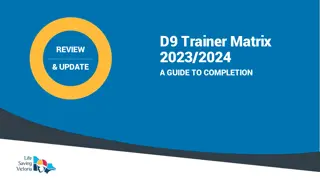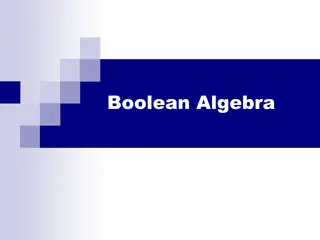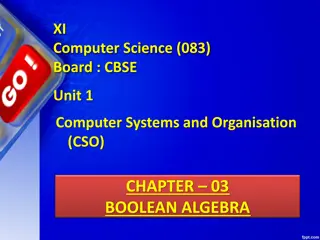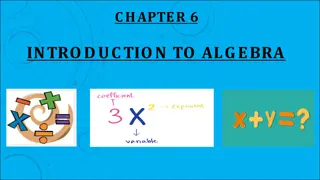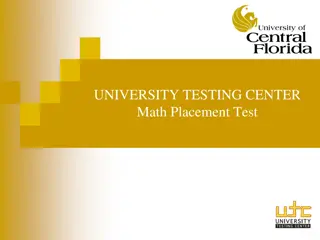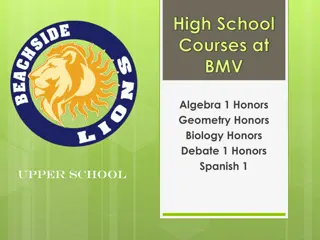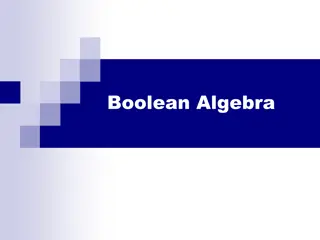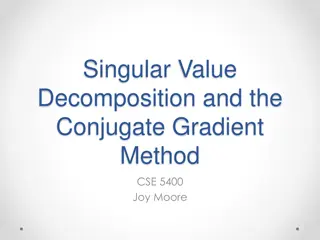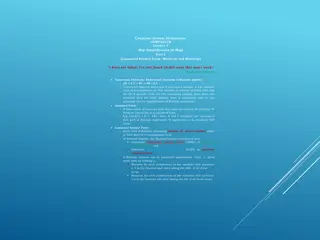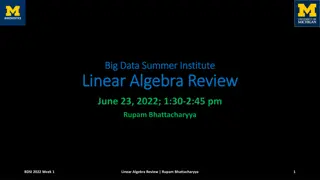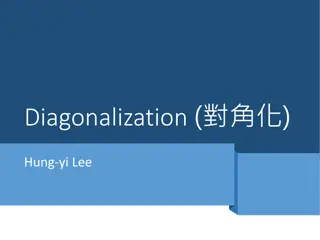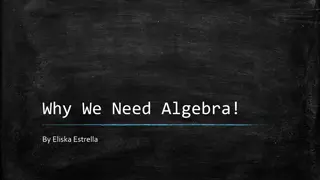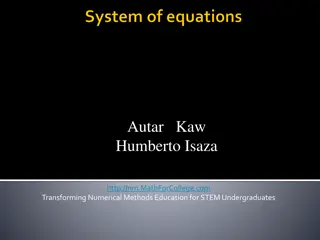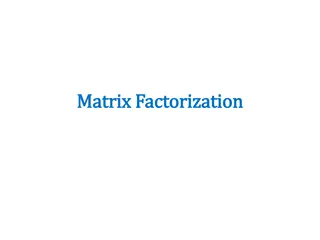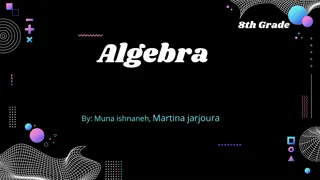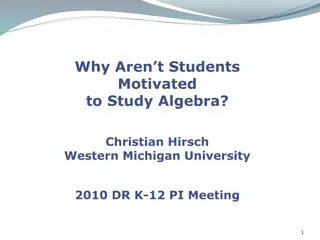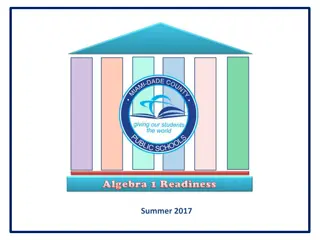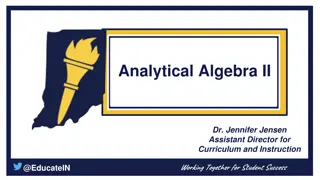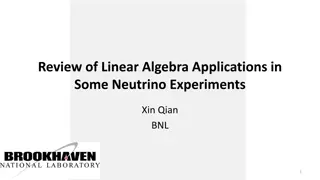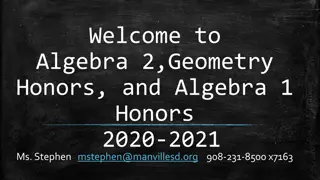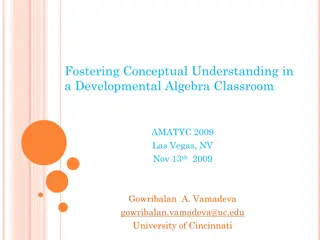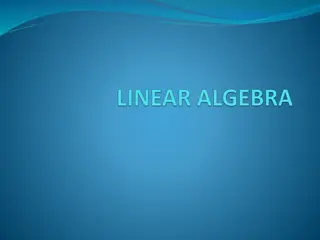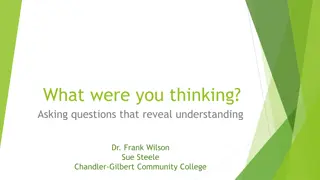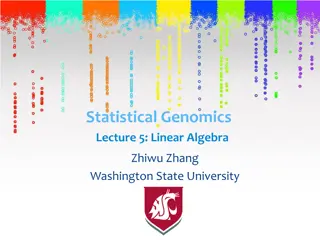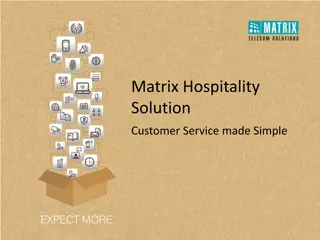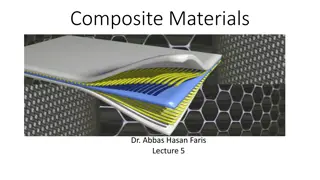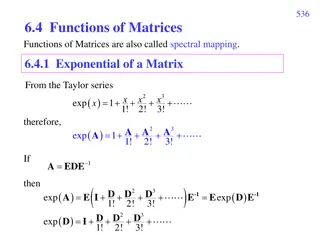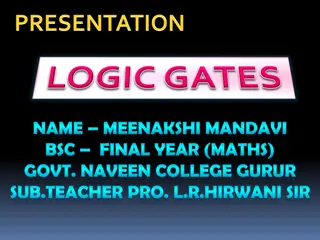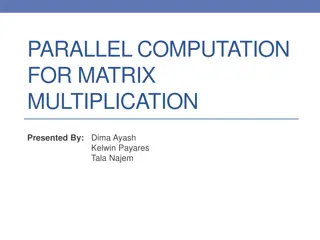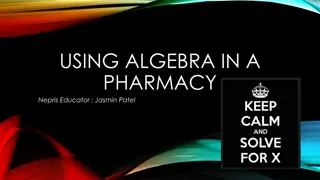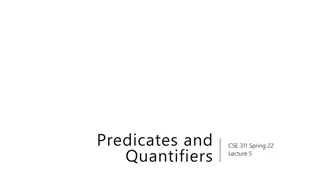The Importance of Completing a Trainer Matrix
Completing a Trainer Matrix is essential for Registered Training Organizations (RTOs) to demonstrate compliance with Standards for RTOs 2015, specifically Clauses 1.13 to 1.16. This matrix outlines requirements for trainers, including holding relevant qualifications, industry skills, and maintaining
2 views • 38 slides
Eigen: High-Level C++ Library for Linear Algebra
Eigen is a high-level C++ library offering a range of functionalities for linear algebra, matrix and vector operations, geometrical transformations, numerical solvers, and related algorithms. It provides efficient multidimensional array storage, fast math operations, and linear algebra capabilities.
0 views • 12 slides
Boolean Algebra and Logical Statements
Introduction to Boolean algebra, logical statements, and compound statements. Explore the concepts of Boolean variables, logical operators, writing conventions, equivalence in Boolean algebra, and truth tables. Learn how to analyze and evaluate logical expressions using truth tables.
1 views • 25 slides
Boolean Algebra in Computer Science
Boolean algebra, developed by mathematician George Boole, is essential in computer systems for performing logical operations with True and False values represented as 1 and 0. It involves operators like AND, OR, and NOT, enabling digital computers to process information effectively. Truth tables aid
0 views • 52 slides
Introduction to Algebra: Understanding the Basics and History
Algebra, a fundamental branch of mathematics, uses letters and symbols to represent numbers and quantities in equations. This chapter covers the history of algebra, from its origins in ancient Egypt to its development by mathematicians like Al-Khwarizmi and Viète. Students will learn to work with a
5 views • 45 slides
University Math Placement Test Overview
The University Math Placement Test is a tool to help place students accurately into math courses, ensuring their success. It consists of three practice tests - Algebra, Trigonometry, and Precalculus. Students start with the Practice Algebra Test and have the opportunity to advance based on their sco
2 views • 13 slides
Diverse High School Courses at BMV: Algebra, Geometry, Biology, Debate, Spanish
Explore a variety of high school courses at BMV including Algebra 1 Honors, Geometry Honors, Biology Honors, Debate, and Spanish 1. These courses offer a comprehensive range of subjects from math to language arts, preparing students for advanced studies and fulfilling graduation requirements. Studen
0 views • 19 slides
Boolean Algebra and Logical Statements
Boolean Algebra allows for formalizing logical reasoning using variables that can be either true or false. It involves logical statements, compound expressions, logical operators like AND, OR, NOT, writing conventions, equivalence, and truth tables to determine the truth values of statements. By und
0 views • 25 slides
Singular Value Decomposition and the Conjugate Gradient Method
Singular Value Decomposition (SVD) is a powerful method that decomposes a matrix into orthogonal matrices and diagonal matrices. It helps in understanding the range, rank, nullity, and goal of matrix transformations. The method involves decomposing a matrix into basis vectors that span its range, id
0 views • 21 slides
Boolean Algebra: Canonical Normal Form, Minterms, and Maxterms Explained
Boolean algebra concepts including Canonical Normal Form, Minterms, and Maxterms are discussed in detail, along with examples and truth table representations. The Consensus Theorem and Redundant Theorem of Boolean Algebra are also explained, highlighting simplification techniques for Boolean express
0 views • 5 slides
Linear Algebra Review for Big Data Summer Institute
Join Rupam Bhattacharyya at the Big Data Summer Institute for a comprehensive review of linear algebra concepts. Explore topics such as matrix notation, special matrices, shapes of matrices, and matrix operations. Gain valuable insights for applications in big data analysis and machine learning.
0 views • 18 slides
Diagonalization in Linear Algebra
Discover the concept of diagonalization in linear algebra through eigenvectors, eigenvalues, and diagonal matrices. Learn the conditions for a matrix to be diagonalizable, the importance of eigenvectors in forming an invertible matrix, and the step-by-step process to diagonalize a matrix by finding
0 views • 26 slides
The Importance of Algebra in Everyday Life
Algebra plays a crucial role in various professions and daily activities such as shopping, budgeting, and problem-solving. It is essential for jobs in fields like farming, construction, animation, computer science, and more. Utilizing algebraic formulas can help in practical scenarios, like determin
1 views • 17 slides
Matrix Algebra for Solving Systems of Equations
Explore the application of matrix algebra in solving systems of equations through a practical example involving the interpolation of rocket velocity data. Learn how to set up equations in matrix form to find the coefficients profile of the velocity polynomial, illustrating the concept effectively.
0 views • 71 slides
Rank and Nullity in Linear Algebra
The rank of a matrix is the maximum number of linearly independent columns, while the nullity is obtained by subtracting the rank from the number of columns. Linearly independent columns form the basis for the rank of a matrix, helping determine if a given matrix has a unique solution, infinite solu
0 views • 6 slides
Matrix Factorization for Latent Factor Recovery
Explore the concept of matrix factorization for recovering latent factors in a matrix, specifically focusing on user ratings of movies. This technique involves decomposing a matrix into multiple matrices to extract hidden patterns and relationships. The process is crucial for tasks like image denois
0 views • 50 slides
Algebra
Dive into the world of 8th-grade algebra with Muna Ishnaneh and Martina Jarjoura. Learn about variables, mathematical expressions, and operations like addition and subtraction through examples and exercises. Explore resources to enhance your algebra skills and conquer math challenges!
0 views • 8 slides
Challenges in Motivating Students to Study Algebra: Insights from Surveys and Recommendations
Teachers face challenges in motivating students to study Algebra, as highlighted by survey findings. The most significant issues include working with unmotivated students, making mathematics accessible, and poor background preparation in certain topics. Recommendations focus on key topics of school
0 views • 13 slides
The Oldest Applications of Linear Algebra in Ancient Civilizations
Linear algebra has roots in ancient civilizations like Egypt, where mathematical problems related to land measurement, resource distribution, and taxation were solved using techniques like Gaussian elimination and Cramer's Rule. The Rhind Papyrus from 1650 B.C. contains examples of linear systems an
0 views • 30 slides
Enhancing Algebra Teaching Strategies for Educators
Dive into a comprehensive resource on effective algebra teaching methods, including tips on simplification, substitution, linear equation solving, and more. Discover the importance of proper algebra techniques and how to make the learning process more engaging for students. Explore the evolution of
0 views • 38 slides
The World of Algebra: Introduction, Uses, and Importance
Algebra is a fundamental branch of mathematics that involves solving equations with unknown variables. This post covers the definition of algebra, its significance in real life, the Father of Algebra – al-Khwarizmi, reasons for studying algebra, and practical applications like time management and
0 views • 8 slides
Algebra 1 Honors Readiness and Accelerated Student Path Overview
Understand the importance of Algebra 1 Honors preparation, required concepts, and graduation criteria. Dive into the accelerated student path standards post 6th grade. Topics include fractions, equations, proportions, statistics, and probability. Ensure readiness for a successful Algebra 1 journey.
1 views • 19 slides
Enhancing Algebra II Education for Student Success
Analytical Algebra II focuses on project-based learning with technology integration, aligning with postsecondary preparation standards. Parameters of HEA 1426 ensure course difficulty meets requirements. Considerations emphasize the importance of algebra in college readiness and achieving academic s
0 views • 5 slides
Linear Algebra Applications in Neutrino Experiments
Linear Algebra plays a crucial role in various neutrino experiments, enabling solutions in weighted least squares, energy estimation in EXO-200, and signal processing in LArTPC detectors. From Cartesian coordinates to minimizing uncertainties, linear algebra techniques contribute significantly to da
0 views • 38 slides
Mr. Buchanan's Algebra 1 Class Information
Explore detailed information about Mr. Buchanan's Algebra 1 class for the academic year 2017-2018, including expectations, homework guidelines, calculator policy, class routines, and more. Get ready for an engaging learning experience in Algebra 1 with Mr. Buchanan!
0 views • 9 slides
Reimagining Algebra Education for Non-STEM Majors: Insights from AMATYC Conference 2016
Explore the need for an algebra course tailored to non-STEM majors based on discussions at the AMATYC Conference 2016. Discover insights on revising algebra sequences, eliminating topics, and enhancing focus areas. Uncover enrollment statistics, departmental offerings, and alternative programs resha
0 views • 16 slides
GCSE Algebra Revision Materials and Equations Practice
Explore a collection of GCSE algebra revision materials, including solving linear equations and common mishaps in algebraic simplification. Practice setting up equations and solving linear equations with provided examples and questions. Enhance your algebra skills through comprehensive content desig
0 views • 15 slides
Ms. Stephen's Algebra and Geometry Course Information
Ms. Stephen's 2020-2021 Algebra 2, Geometry Honors, and Algebra 1 Honors course details. Grading policy, resources on Canvas, Deltamath, Edulastic, and Edpuzzle. Built-in TI-84 calculator on Chromebook. Office hours for extra help and communication methods provided. Zoom or in-person meetings availa
0 views • 7 slides
Developmental Algebra Classroom: Fostering Conceptual Understanding
Explore the journey through developmental algebra classes focusing on fostering conceptual understanding. Delve into topics spanning Elementary Algebra I, II, III, graphing equations, traditional definitions, and more. Discover key concepts like fractions, functions, factorization, and the importanc
1 views • 14 slides
Linear Equations and Matrix Operations
Explore the concepts of linear equations, matrix forms, determinants, and finding solutions for variables like x1, x2, x3. Learn about Cramer's Rules, Adjoint Matrix, and calculating the inverse of a matrix through examples and formulas.
0 views • 24 slides
Enhancing Student Understanding in College Algebra Assessments
Dr. Frank Wilson and Sue Steele from Chandler-Gilbert Community College discuss the issue of students memorizing procedures instead of actually understanding concepts in college algebra. They present a case study highlighting the importance of assessing conceptual mastery over procedural knowledge.
0 views • 31 slides
Statistical Genomics Lecture 5: Linear Algebra Homework Questions
Explore the concepts of random variables, covariance matrix, special matrices, and self-defined functions in statistical genomics through a series of homework questions. Gain insights into linear algebra and statistical genomics while working on Homework 1, analyzing the expectation and variance of
0 views • 22 slides
Revolutionizing Hotel Communication with Matrix Hospitality Solution
Simplify hotel operations and enhance guest experiences with Matrix Hospitality Solution. From enhancing staff efficiency to boosting revenue generation opportunities, Matrix offers a comprehensive suite of features to meet the diverse needs of hotels. Its modular configuration, scalable platform, a
1 views • 36 slides
Composite Matrix Materials in Engineering
Composite materials are made of reinforcing fibers and matrix materials, with the matrix serving to protect and enhance the properties of the composite. There are three main types of composite matrix materials: metal matrix composites (MMC), ceramic matrix composites (CMC), and polymer matrix compos
0 views • 22 slides
Matrix Functions and Taylor Series in Mathematics
A detailed exploration of functions of matrices, including exponential of a matrix, eigenvector sets, eigenvalues, Jordan-Canonical form, and applications of Taylor series to compute matrix functions like cosine. The content provides a deep dive into spectral mapping, eigenvalues, eigenvectors, and
0 views • 53 slides
Introduction to Logic Gates: Understanding Boolean Algebra and Applications
Meenakshi Mandavi, a final year BSc Mathematics student, discusses Logic Gates, Boolean Algebra, discovery of Boolean Algebra by George Boole, types of Logic Gates such as OR, AND, NOT, NAND, NOR, their universal properties, and uses in calculators and computers.
0 views • 8 slides
Parallel Computation for Matrix Multiplication
Matrix multiplication is a fundamental operation with diverse applications across scientific research. Parallel computation for matrix multiplication involves distributing the computational workload over multiple processors, improving efficiency. Different algorithms have been developed for multiply
0 views • 36 slides
Algebra Application in Pharmacy: Solving Two-Step Equations
Pharmacists indeed use algebra in their profession, involving basic algebra, fractions, percentages, and ratios to ensure accurate dosage calculations for medications. Solving for unknown variables in two-step equations is beneficial for pharmacists, as demonstrated in real-life scenarios like deter
0 views • 39 slides
Boolean Algebra: Predicates and Quantifiers in CSE 311 Spring '22 Lecture 5
Dive into the world of Boolean Algebra with this comprehensive guide that explores the fundamentals of predicates, quantifiers, and their applications in computer science and circuit design. Discover the concepts behind Boolean variables, logical operations, and equivalence in Propositional Logic. E
0 views • 52 slides
Pre-Algebra Problem Solving and Expressions Review
Dive into solving pre-algebra problems involving PEMDAS, distributive property, and expressions related to babysitting wages, bead designs, shopping expenses, and phone usage minutes. Learn step-by-step methods, examples, and counterexamples to strengthen your pre-algebra skills.
0 views • 28 slides
